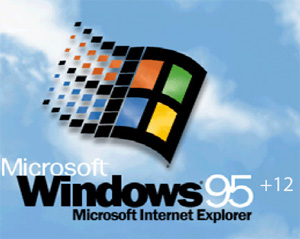Vista isn't Me2, it's Win95 + 12 years

In certain circles, it’s become fashionable of late to refer to Windows Vista as Windows Me2. It’s the second-worst insult you can hurl at a Microsoft program (the worst is to compare it to Microsoft Bob, neatly summarized as “7th place in PC World Magazine's list of the 25 worst products of all time and [named] worst product of the decade by CNET.com” in 2005.).
Windows Vista is no Bob, as Steve Ballmer has said publicly, on the record. But if you believe the comparison, Vista is heading down a path roughly the same as Windows Millennium Edition (aka Windows Me).

So does Windows Vista deserve the Me2 label? After a careful look back at my Windows history books, I see Vista heading down a different path. In fact, I’m struck by how similar Vista’s path so far has been to the one that Windows 95 traveled. Let’s review: Windows 95 was launched with tremendous expectations on a tsunami of hype. It was notoriously unstable and finicky, and for the first year or two there weren’t all that many 32–bit programs. A total of four OEM service releases (in 1996 and 1997) added some interesting new features (like FAT32) but didn’t deal with the significant underlying problems of the OS.
It wasn’t until three years after Windows 95’s launch, with Windows 98 (and Windows 98 Second Edition a year after that) that the stability, performance, and interface problems were finally dealt with.
The similarities with Windows Vista are striking:
Unachievable levels of hype. The hype for Windows 95 was unprecedented, finally leading to Windows boss Brad Silverberg’s award-winning entry in the Tamping Down Expectations sweepstakes:
“"It's just software," says Silverberg. "It doesn't cure cancer. It doesn't grow hair. It's not a floor wax. It's Windows."
Windows Vista’s planners tried not to fall into the hype trap, but they failed. When the grand, sweeping plans for what was then code-named “Longhorn” were scaled back in 2004 (the great Longhorn reset), the narrative of Vista failure was set in stone.
A very long and public beta. Windows 95 was in wide-scale beta releases for nearly two years. Similarly, the first public beta release of Windows Vista was released in July 2005, roughly 18 months before its eventual final release. Having buggy, incomplete code in your users’ hands for that long guarantees disappointment in the final release.
Initial compatibility, performance, and stability problems. If you ever tried to install a sound card or set up a network in Windows 95, you knew the definition of great pain. Early Vista adopters are reporting similar performance and compatibility problems, most of them traceable to problems with buggy or incomplete drivers.
A beginning, not an end. Windows 95 marked the beginning of a new development platform, one that didn’t truly hit its stride until several years after its release. With its shift to 64–bit computing, a new driver model, and a new kernel, Windows Vista is similarly at the beginning of a cycle. By contrast, Windows Me was a stopgap release, the end of the hybrid 16/32–bit era. Its successor, Windows XP, would be released a year later. Microsoft wasn’t committed to developing it and was only too happy to drop it in favor of the technically superior XP platform.
If Windows Vista follows the path of Windows 95, it’s here to stay, and here’s what you can expect:
Service Pack 1 won’t work miracles. Microsoft is right to dampen expectations for SP1. Although it should fix some of the high-profile problems being reported now, I predict you’ll read another wave of disappointing reviews when SP1 arrives next year.
Businesses will continue to stay away from Vista in droves. They have a perfectly acceptable alternative in Windows XP, and there’s little upside in upgrading.
Expect a major update Vista update after three years. Between now and 2010, Microsoft has a chance to do for Vista what Windows 98 did for Windows 95. The challenges? Polish the bundled releases into something that looks more like an integrated suite. Improve reliability by making it more difficult for buggy drivers and apps to get on the system, perhaps by going all-64 bit and enforcing the requirement for signed drivers. Fix User Account Control.
If history repeats itself, Microsoft will release its next Vista update in 2009 or 2010, after a low-profile, secretive beta cycle, and it will be greeted as finally delivering on the promise of what Vista should have been all along.